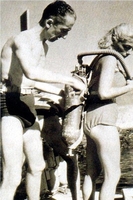Items
Site
The Medicine Chest
keywords is exactly
funding
-

Melchior & Cousteau
In 1963 Simone Melchior became the world's first female aquanaut by living in Starfish House, an underwater habitat, for the final four days of the Conshelf II project. Although never visible in the 'Undersea World of Jacques Cousteau' series, Cousteau's wife and business partner played a key role in the operation at sea. She was the acting mother, healer, nurse and psychiatrist to the all-male crew for 40 years. Cousteau describes her as being "happiest out of camera range, in the crow’s nest of the Calypso (...), scanning the sea for whales". Her father, Henri Melchior, was director of Air Liquide (France’s main producer of industrial gases at the time) and funded the invention of the aqua lung and the scuba diving apparatus we know today. -

Smallpox
"In Kimberley in 1883-4, several leading doctors with links to the diamond-mining industry publicly denied the presence of smallpox among migrant workers, instead diagnosing them as suffering from a rare skin disease. They appear to have done so lest admitting that the dreaded smallpox was raging, which would have affected the supply of labour and materiel and thereby interrupting mining operations. Led by Cecil Rhodes’s friend, Dr Leander Starr Jameson, measures to curb the epidemic were sporadic or, in the mining compounds, non-existent, and cases topped 2000, with mortality at 3.5 per cent of the population. Only when the colonial government eventually called in external doctors to diagnose the disease, was the cover-up terminated and vaccination, fumigation and isolation vigorously pursued. The conspiracy of denial, by retarding action and sowing doubt about the need to be vaccinated, had been responsible for no small percentage of the 700 deaths in the town" (Phillips 2012: 32-33). -

Kimberlite
"UCT was founded in 1829 as the South African College, a high school for boys. The College had a small tertiary-education facility that grew substantially after 1880, when the discovery of gold and diamonds in the north – and the resulting demand for skills in mining – gave it the financial boost it needed to grow. The College developed into a fully fledged university during the period 1880 to 1900, thanks to increased funding from private sources and the government. During these years, the College built its first dedicated science laboratories, and started the departments of mineralogy and geology to meet the need for skilled personnel in the country's emerging diamond and gold-mining industries (Ritchie 1918: 495-496)".


